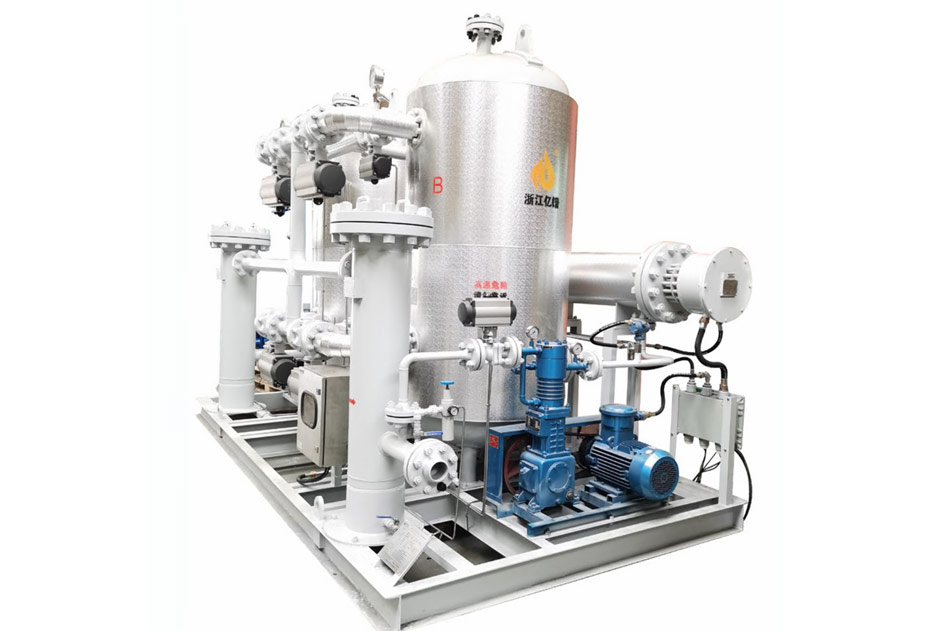CNG Refueling Station Dehydration Solutions
Industry Pain Points
Moisture-Induced Equipment Corrosion: During CNG compression, moisture combines with H₂S/CO₂ to form acidic condensate, which corrodes compressor cylinders and gas storage cylinder banks. This increases average maintenance costs by 40%.
Reduced Refueling Efficiency: Each 1% volume of moisture occupies gas storage space, leading to a 5-8% reduction in refueling volume. Annual losses per station exceed 500,000 yuan.
Ice Blockage Risk: During pressure reduction in winter, moisture freezes and causes frost cracking of solenoid valves in refueling machines. The average annual failure rate per station is ≥8 times.
Limitations of Traditional Technologies: Adsorbent desiccants require frequent replacement (every 3-6 months); TEG systems need continuous power supply and pose a risk of benzene-series compound emissions.
System Overview
Through the “hypergravity separation – intelligent condensation – high-pressure adsorption” technology chain, Yipu CNG Refueling Station Dehydration System achieves:
- Zero Equipment Corrosion: Completely solves the problem of compressor cylinder rust caused by moisture.
- Increased Refueling Volume: After dehydration, the gas storage volume of a single cylinder bank increases by 7%, generating over 1 million yuan in additional annual revenue.
- Full-Life-Cycle Service: Provides a 5-year warranty, including free digital operation and maintenance (O&M) support.
Technological Evolution:
- Launched a hydrogen-compatible dehydrator in 2024, suitable for CNG-H₂ mixed gas (H₂ ≤20%).
- Developed an integrated skid-mounted module to enable rapid station construction within 72 hours.
Solution Approach
Yipu CNG Dehydration System Solution
| Module | Technical Highlights | Performance Parameters |
|---|---|---|
| Gas-Liquid Separator | 316L stainless steel + glass fiber coalescing layer | Liquid droplet removal rate ≥99%, pressure loss ≤0.005MPa |
| Intelligent Condensing Unit | Variable-frequency refrigeration + AI load prediction, 30% energy saving | Dew point -15℃, adapts to 10-100% load fluctuation |
| High-Pressure Adsorption Tower | Carbon fiber-wound shell, pressure resistance of 25MPa | Outlet dew point -60℃, service life ≥5 years |
| Renewable Energy System | Recovers compressor cylinder jacket waste heat (80-120℃) | Regeneration energy consumption ≤0.03kWh/Nm³ |
| IoT Monitoring System | Real-time monitoring of dew point and flow, automatic early warning of ice blockage risk | Fault prediction accuracy ≥98% |
Applicable Scenarios:
- CNG dehydration at mother/sub-stations
- LNG-CNG combined stations
- Mobile refueling vehicles
Technical Principles
Yipu Three-Stage Deep Dehydration Process:
- Preliminary High-Efficiency Separation (Stage 1):The axial hypergravity separator removes 95% of free water within 0.5 seconds, with a treatment capacity of up to 3000 Nm³/h.
- Intelligent Condensation (Stage 2):The variable-frequency refrigeration unit automatically adjusts according to gas volume, cooling the gas from 40℃ to 3℃ and reducing the dew point to -15℃.
- Composite Adsorption (Stage 3):Hydrophobic molecular sieves (patented 3A-CNG model) achieve deep dehydration under 20MPa high pressure, maintaining a stable dew point of -60℃ (moisture ≤1mg/m³).
- Energy Recovery:Uses compressor waste heat to regenerate adsorbents, reducing energy consumption by 60%.
Core Advantage
| Advantage | Details |
|---|---|
| Customized on Demand | Meets special working conditions; provides professional non-standard customization |
| Low Cost | Adopts cyclic regeneration process; significantly reduces operating costs |
| High Stability | Dual-tower structure with small pressure fluctuation; low noise and continuous gas supply |
| Fully Automatic Operation | Easy to operate, reducing labor input; improves efficiency |
| High Safety | Presets multi-level safety protection measures; supports automatic alarm |
| Low Failure Rate | Maintains low failure rate after 10,000 hours; high durability with almost no maintenance required |
Technical Strength
Leading Adsorption Dehydration Technology
Uses high-performance molecular sieve adsorbents with high water absorption capacity and resistance to corrosion by acidic gases (H₂S/CO₂), ensuring deep dehydration with a dew point ≤-70℃.
The original hot nitrogen regeneration process reduces energy consumption by 30% compared with traditional electric heating regeneration, and integrates a waste heat recovery system to significantly improve energy efficiency.
Modular and Customized Design Capability
Core equipment adopts modular prefabrication, supporting rapid deployment (installation cycle shortened by 50%) and adapting to diverse scenarios such as offshore platforms, onshore gas fields, and LNG pretreatment.
Can customize single-tower, dual-tower, or multi-tower parallel systems according to customer needs, with a treatment capacity ranging from 10,000 to 1,000,000 Nm³/d, flexibly matching gas fields of different scales.
Intelligent Control and Remote Operation & Maintenance
Equipped with a PLC+IoT intelligent control system, it real-time monitors key parameters such as pressure, temperature, and dew point, supporting fault early warning and automatic adjustment.
Through cloud-based big data analysis, it optimizes the adsorption-regeneration cycle, extends the service life of molecular sieves, and reduces O&M costs by 10%-15%.
Energy-Saving and Environmental Protection Technology
Features zero-emission design for regeneration exhaust gas, complying with international environmental standards such as EU CE and US EPA.
Energy consumption is 25%-40% lower than that of traditional triethylene glycol (TEG) dehydration systems, helping customers achieve carbon emission reduction goals.
Long-Cycle Operation Reliability
Molecular sieves adopt anti-pulverization coating technology, with a service life of over 5 years, reducing replacement frequency.
Key components (e.g., valves, instruments) are selected from international first-tier brands (e.g., Siemens, Emerson), with a Mean Time Between Failures (MTBF) of over 100,000 hours.
Strong R&D and Engineering Experience
Possesses more than 19 patents and software copyrights in dehydration technology; the R&D team is led by doctors and has in-depth cooperation with universities and colleges.
Has over 1,000 successful cases worldwide, covering extreme working conditions such as high-sulfur gas fields in the Middle East and low-temperature environments in the Arctic.
Product Advantage Comparison
| Indicator | Yipu System | TEG Dehydration | Refrigeration Method | Competitor Adsorption Systems |
|---|---|---|---|---|
| Dew Point | -60℃ (normal state) | -30℃ (requires deep regeneration) | -20℃ | -45℃ (4 replacements per year) |
| Energy Consumption | 0.05kWh/Nm³ (including recovery) | 0.18kWh/Nm³ | 0.12kWh/Nm³ | 0.1kWh/Nm³ |
| Maintenance Cost | <0.02 RMB/Nm³ (5-year service life) | 0.1 RMB/Nm³ (TEG + electricity cost) | 0.07 RMB/Nm³ | 0.15 RMB/Nm³ (consumables) |
| Pressure Adaptability | Lossless operation at 0.5-25MPa | Only applicable for ≤8MPa | Requires stable pressure | 1-20MPa |
| Environmental Friendliness | Zero chemicals, zero emissions | Risk of benzene-series compound emissions | Potential refrigerant leakage | Difficult molecular sieve waste disposal |
Typical Case
Project Name: Renovation of a CNG Mother Station in the West-East Gas Pipeline
Operating Conditions:
- Treatment Capacity: 20,000 Nm³/day, pressure 0.8-20MPa
- Gas Quality: H₂S 50ppm, water-saturated
Dehydration Effect:
- Dew point stably reduced from +25℃ to -65℃
- Compressor overhaul cycle extended from 1 year to 3 years
Economic Benefits:
- Reduced annual refueling volume loss by 1.8 million yuan
- Saved 800,000 yuan in maintenance costs per year

